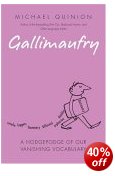a hodgepodge of our vanishing vocabulary
Michael Quinion is a word nerd. He’s an expert on obscure terms, word etymologies, and the origins of strange expressions. His last book Port Out, Starboard Home discusses myths and false explanations for the meanings of well known sayings, and he runs an excellent compilation of lexical back-history at World Wide Words. Gallimaufry is his latest collection of notes on ‘disappearing language’ – terms that are vanishing from common usage for a variety of reasons.
 Some go because the object they describe no longer exists (liberty-bodice and sixpence) and some are meanings that disappear because the word is now used to describe something quite different (chaperone was in medieval times a sort of cap.) Mercifully, he splits up his offerings into themed chapters – on food and drink, health and medicine, entertainment and leisure, transport and fashion, then family names and communication.
Some go because the object they describe no longer exists (liberty-bodice and sixpence) and some are meanings that disappear because the word is now used to describe something quite different (chaperone was in medieval times a sort of cap.) Mercifully, he splits up his offerings into themed chapters – on food and drink, health and medicine, entertainment and leisure, transport and fashion, then family names and communication.
In explaining the meaning of terms such as lamprey-pie, hog’s pudding, and flummery, he takes you into the realms of medieval cooking practices, the relationship of Latin and French to English linguistic development, and the eating habits of kings and commoners as they struggled to add nutrition and flavour to their diet of boiled wheats and gruel.
In no time this leads in its turn to the worlds of medicine, naval history, and eighteenth century nutrition. It’s unlikely that anybody will need to bring many of these terms back into general circulation, but it’s interesting to realise that spalling-poppy, biting assmart, and alexipharmic contain lexical elements which are still alive and well today, even though we have stopped using the herbal remedies to which they refer.
These are not just terms that have disappeared, but also the remote origins of terms which we still use today. For instance, you would never guess that the term slush fund originated in the mass of semi-liquid fat that floated on the top of boiling up unappetising salt pork on board a ship.
This all passes later into a form of social history when Quinion describes the forms of long-forgotten dances such as the cotillion, the quadrille, and the galliard. He then goes on to explain the distinctions between various nineteenth-century vehicles such as the landau, the barouche, the cabriolet, and the handsome.
It’s a gold mine for people who enjoy both arcane knowledge and the strange linguistic depths of the everyday world. For instance, he discusses old forms of measurement (of the rod, perch, and pole variety) and points out that ell, the old way to measure woollen cloth, gets its length (22-23 inches) as well as its name from the fact that this is the approximate distance from the shoulder to the wrist. The Old English term for the arm is ell, which is why in its turn the place where it bends is called the elbow.
Quinion is certainly a scholar. He gives meticulously drawn sources for his definitions and admits doubt or complete ignorance when supporting evidence is not available. He finishes with a selection of terms which are probably on their way out because of technological change: blotting paper, usherette, gramophone, and bus conductor will probably never be required again, even though they are probably still in the active vocabulary of older people today.
OK – you are either interested in old and possibly obscure words or you’re not. This is a cornucopia for those of us who are not ashamed to be counted amongst the lexical anoraks.
© Roy Johnson 2008
![]() Buy the book at Amazon UK Buy the book at Amazon US
Buy the book at Amazon UK Buy the book at Amazon US
Michael Quinion, Gallimaufry, Oxford: Oxford University Press, 2008, pp.288, ISBN: 0199551022